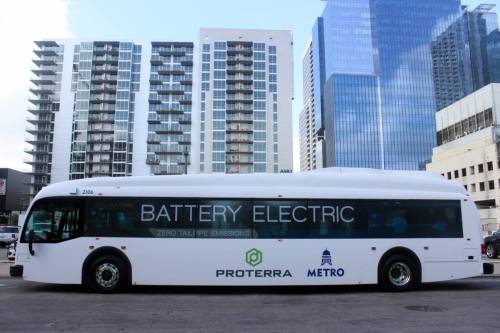Capital Metro’s future will be electrified as the agency began testing electric buses Tuesday in Austin.
Over the next six weeks, the agency will test electric buses from three manufacturers, including California-based Proterra, which has sold about 700 buses and opened a second manufacturing facility to handle those orders, Proterra Regional Sales Director Lauren Cochran said.
During the testing phase, Capital Metro will add the electric bus as a supplement to its regular service so riders will not have to pay a fare, the agency’s President and CEO Randy Clarke said. The agency will note how the bus operates in Austin’s heat and hilly topography.
“Part of the test phase is to see how long these can last in the service environment,” he said.
Riders can follow Capital Metro on social media to find out which route the bus is traveling that day. The first rider to spot the bus, post a photo on Twitter and tag @CapMetroATX will win a 10-day commuter pass.
Electrified fleet
Electric buses typically can get up to 26 miles per diesel gallon compared to 3-4 miles per gallon of a traditional diesel-powered bus and do not have a tailpipe so they produce zero emissions, Cochran said. Besides operating more cleanly and efficiently than a traditional bus, she said drivers have also noted the buses are quieter.
“We can operate quietly in neighborhoods with low noise levels,” Cochran said.
Buses can take three to six hours to charge depending on whether a 60 kilowatt or 125 kilowatt charger is available and if the battery has been depleted, Cochran said.
On a single charge, an electric bus could travel as much as 175 miles, which is more than enough time for Capital Metro’s fleet to complete a 14-hour service day, said Jenn Golech, Capital Metro’s manager of service and projects, planning and implementation.
In July,
during a budget presentation and update on the transit agency’s five-year capital plan, staffers revealed Capital Metro could begin purchasing electric buses starting in fiscal year 2021-22. The agency anticipates spending almost $20 million in FY 2021-22 to purchase 40 buses, according to a July presentation.
The buses would require more capital upfront, about $800,000 versus $500,000, but over the lifespan of a bus, about 12 years, the agency would see savings in fuel costs, Clarke said. The lifetime cost of an electric bus is estimated at $1.18 million compared to $1.34 million for a diesel bus, according to the presentation.
Future of electric
Electric buses fit into Capital Metro’s future as part as of the acronym ACES: autonomous, connected, electric and share. Capital Metro has already started testing an autonomous shuttle that could start later in 2018 in downtown Austin.
“We’re the ultimate in share; no one does share vehicles, like ride-sharing, like us,” Clarke said. “Electric is clearly now the place [people] are going that way. We believe a piece of the future is autonomous and connected.”
Capital Metro board member Ann Kitchen, who also sits on Austin City Council and has been championing the agency pursuing electric buses, said the agency is starting with a smaller purchase at first to make sure it has everything it needs for an electric fleet.
“The biggest question for us from Cap Metro’s perspective is you have to change the whole system,” she said. “You have to look at it all the way from the infrastructure—we’ll be working with Austin Energy—where we plug them in, how we plug them in, all the way to what do we do with the batteries once they’re done because we can reuse them. It’s a system plan.”








